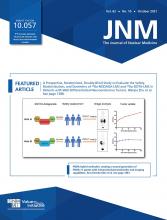TO THE EDITOR: In a recent review, van Dongen et al. illustrated why 89Zr-immuno-PET has become an important tool for the in vivo characterization of novel biologic drugs and their targets (1). A technical “State of the Art” article summarized PET quantification of 89Zr-tracer uptake, stressing that total tissue uptake results from a target-specific and a nonspecific contribution. The latter involves a first, so-called reversible, part related to free tracer in blood and interstitium, quantified by the Patlak y-intercept (Vt). The second, irreversible, part is related to 89Zr residualization after monoclonal antibody (mAb) uptake and degradation by antigen-negative cells, quantified by the Patlak uptake-rate constant (Ki). This description is fully in line with a previous study coauthored by van Dongen, using Patlak analysis in normal tissues (kidney, liver, lung, and spleen) without known target expression for 4 89Zr-labeled mAbs, respectively (2). van Dongen et al. thus suggested that future quantitative 89Zr-immuno-PET studies should consider multiple-time-point acquisitions to assess nonspecific uptake versus time, with at least 3 late time points, and that sophisticated modeling strategies should be developed (1,2).
We believe that this suggestion warrants further comments that might be helpful for anticipating quantitative 89Zr-immuno-PET studies in tumors, designed for assessing in vivo target engagement. First, the nonspecific-irreversible uptake should be quantitatively compared with the total-tumor uptake, in order to actually determine whether it might be significant or negligible (1,2). To justify this proposal, let us consider recent results about 89Zr-anti-PD-L1, designed for monitoring in vivo chemotherapy-mediated modulation of tumor-PD-L1 expression (3). After extracting tracer input function and tumor data showing irreversible uptake (using the Web-Plot-Digitizer software in Jung et al.’s Figures 2B and 3B, respectively (3)), Patlak analysis provides a total-tumor Ki of 0.0289 mL⋅g−1⋅h−1 (R2 = 0.9993). For comparison, combining 4 89Zr-labeled mAbs, the baseline value of the nonspecific Ki in the kidney, liver, lung, and spleen was previously found to be 0.0007, 0.0011, 0.0002, and 0.0005 mL⋅g−1⋅h−1, respectively (2). The total tumor Ki value of the 89Zr-anti-PD-L1 random example thus appears to be between 26- and 145-fold higher than the nonspecific Ki values of normal tissues. Even assuming that the nonspecific contribution might vary depending on tumors and patients, unlike for normal tissues across patients, we do suggest this first issue deserves consideration.
Second, we suggest that the principle of a 3-time-point method, previously described for quantitative 64Cu-immuno-PET, might be adapted to 89Zr-immuno-PET (4). Rather than the 3 late time points suggested by van Dongen et al., 3 time points are needed at early (after reaching equilibrium), mid, and late imaging, for assessing Ki, Vt, and a release-rate constant (kR). Indeed, we believe the Patlak assumption of irreversible uptake cannot be justified in an arbitrary tissue, including tumors, as evidenced by 64Cu-NOTA-RamAb in VEGFR-2–positive HCC4006 tumors: Ki = 0.0314 mL⋅g−1⋅h−1, kR = 0.0387 h−1, and Vt = 0.2075 mL⋅cm−3 (without a RamAb blocking dose) (4). Noteworthy, this method cannot differentiate between specific and nonspecific uptake, and the actual meaning of the 3 kinetic parameters should be specified under each situation. However, it should be emphasized that a kinetic modeling analysis able to differentiate between specific and nonspecific uptake may probably increase the number of parameters involved in fitting 3-time-point PET data, which is contrary to the Akaike criteria (5). Finally, if nonspecific uptake has proven quantitatively negligible compared with specific uptake, or, alternatively, if differentiating between them has proven unrealistic in current clinical practice, we suggest that a single time point for optimal quantitative 89Zr-immuno-PET might be probed (under the irreversible-trapping condition) (6).
Footnotes
Published online February 26, 2021.
- © 2021 by the Society of Nuclear Medicine and Molecular Imaging.
REFERENCES
- Revision received February 3, 2021.
- Accepted for publication February 5, 2021.







